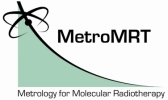WP2: Quantitative Imaging for Molecular Radionuclide Therapy
The overall aim of this workpackage is to provide metrology that will support clinical departments (including non-research departments) to implement routine quantitative imaging on all MRT patients. Specifically it will investigate the accuracy of the various planar and tomographic image reconstruction and correction algorithms. Acquisition parameters will be optimised in order to make recommendations for best practice, and will develop phantoms and procedures for measurement verification and calibration.
Accurate determination of the activity of a radionuclide within a defined anatomy-indexed volume in a patient is fundamental to evaluation of the absorbed dose to a critical target. In order to isolate the volume of interest, an imaging modality must be employed, and planar, SPECT and PET can be used depending on the circumstances (the radionuclide used for therapy, the feasibility of a tracer with a surrogate isotope, etc.). With the advent of hybrid SPECT-CT and PET-CT more accurate localisation of the volume of interest is possible. However the imaging equipment has not been optimised for quantitative measurements, so there are metrological issues that must be addressed. The workpackage takes a practical approach to the problem and will work in close collaboration with clinical departments and will take advice from the EANM (European Association of Nuclear Medicine) and members of the Advisory Board. All quantitative imaging measurements in this workpackage will be carried out by the unfunded JRP-Partners, using the equipment, techniques, and the range of radiopharmaceuticals that they use clinically. Task 2.1 is aimed at defining which radionuclides are suitable for investigation within this JRP and which imaging techniques applied to quantification of the activity of the selected nuclides should be considered. Task 2.2 is focussed on phantom use and development of the selected phantom in order to develop a means of auditing the capability of clinics to perform Quantitative Imaging. Task 2.3 will investigate if necessary corrections need to be applied in order to reach a quantitative evaluation of the images, which will result, in conjunction with the work in WP4, in an estimation of uncertainties related to the different approaches employed by users.
The findings and information from WP2 will be used also as input for Task 3.4 of WP3, where the absorbed dose will be calculated from the cumulated activity inside specific volumes of interest.
Task 2.1: SPECT/PET activity quantification and imaging techniques
The aim of this task is to determine and validate the optimum imaging techniques for the radionuclides corresponding to the radiopharmaceuticals most likely to benefit from the wide scale clinical introduction of quantitative imaging. The task will lead to the development of practical advice on which modality to use (2D versus 3D, tracer activity versus therapeutic activity, PET analogue, bremsstrahlung, etc.), strategies for determining uptake and retention within an anatomical volume (optimal measurement time sequence), and the uncertainties inherent in each modality.
Task 2.2: Calibration phantom
The aim of this task is to provide a phantom, developed within this JRP, suitable for auditing Nuclear Medicine Departments’ capabilities in quantitative imaging. This includes also an investigation of available technology and procedures for the verification of quantitative imaging modalities. The activities in this Task will be performed by the funded JRP-Partners (NMIs and DIs), who will develop a phantom or apply a commercially available phantom, with input from the unfunded JRP-Partners.
Task 2.3: Correction factors and algorithms
The aim of this task is to evaluate correction factors and algorithms necessary to perform quantitative estimations of the source activity from a radionuclide image. Corrections for scatter, attenuation, partial volume effect, and dead-time will be assessed. The two-dimensional and three-dimensional activity distributions will then be obtained by investigating currently available reconstruction methods (i.e. filtered back-projection and iterative reconstruction). Quantitative assessment of the activity will be performed in reference conditions, i.e. uniform activity distribution, absence of background activity and using the reference phantom developed in Task 2.2. The purpose of this task is to investigate each of the calculation elements for accuracy, practicality, and robustness, using both Monte Carlo models and phantom measurements. Radionuclides to be used in this task will be those selected in Task 2.1.
For more information: Contact Vere Smyth

